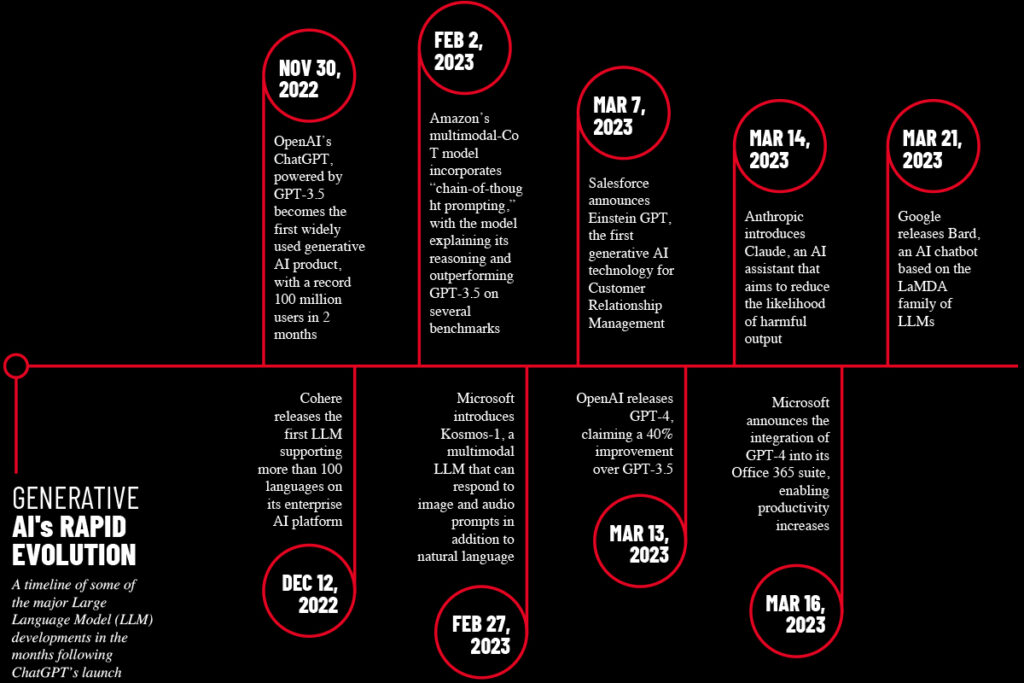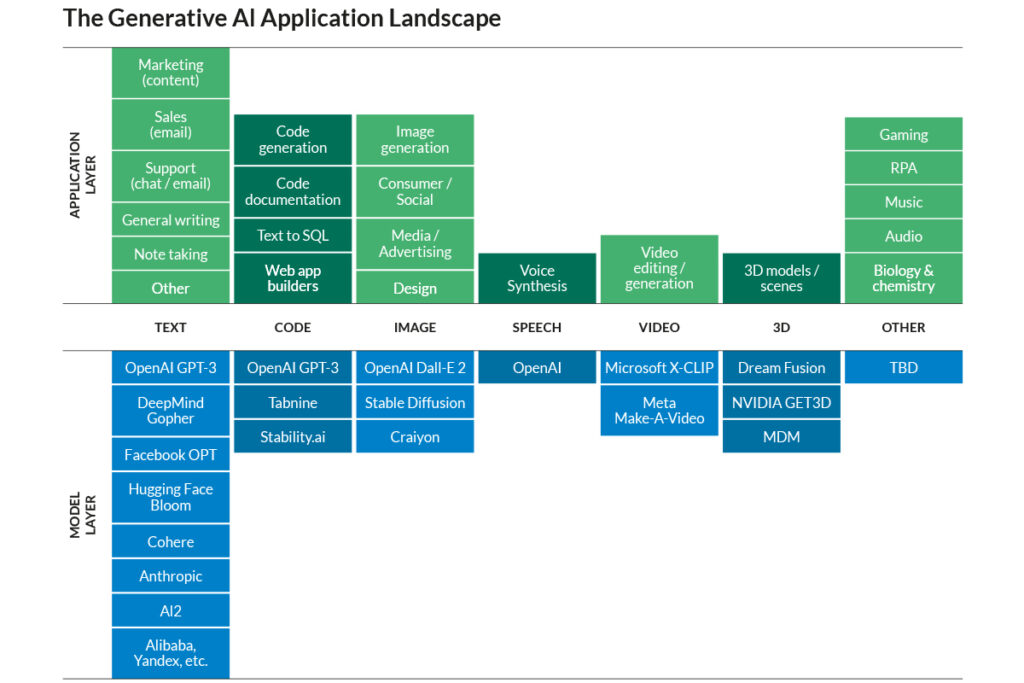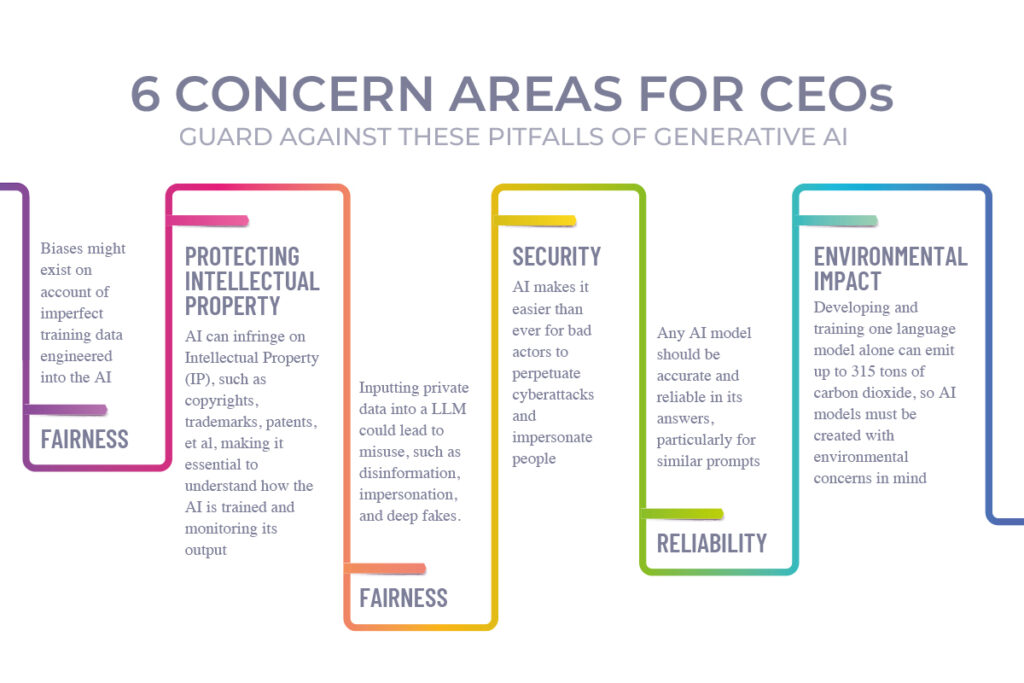Generative AI holds the promise to change the world, but how can CEOs leverage it, and what must they know about this fast-evolving technology?
Words by Karan Karayi
ChatGPT. Bard. Bing. Claude. Midjourney. The list goes on. A glut of generative AI tools have hit the market, creating a groundswell of interest ever since they washed onto the shores of our collective consciousness in late 2022. For the average user, dabbling in this new-age tech meant using it to generate content of some kind, uncovering a productivity hack of some sort, hold conversations with it as they sought to get a peek into its workings, or even create art and music.
These are but a few of its use cases, but for CEOs, the question hanging over their heads is a larger one; is this the crest of the next big wave, an opportunity not to be let go off, or simply a passing phase that can be ridden out? And if there is an opportunity to be unearthed, how can its full value be unlocked?

The potential use cases of generative AI are massive, not just in streamlining the traditional tasks, but creating innovative ways to scale up productivity make it one of the most exciting emergences in quite a while. Imagine an AI model prompting a sales person on ways to upsell a product or service in real time, including providing analytics on the customer’s behaviour and drawing direction from the actual conversation itself. It can also be used to code, write, crunch data and spit out insights, and so much more.
In a nutshell, every knowledge worker stands to gain from a thoughtful application of generative AI. But where should CEOs start their journey? And what must they know before they kick it off? That’s before you even begin to explore how applicable it is in their industry and organisation, and if the workforce has the skills, capabilities, infrastructure, and expertise to make the most of it.
The AI imperative
CEOs simply must consider the use of generative AI. It can’t be seen as an option, lest you be left running in a foot race against greyhounds exploding towards the finish line. The cost of inaction is simply too great, making it imperative to sit with the executive leadership team and chart out an action plan for how to deploy it. This could be across R&D, marketing, sales, manufacturing, customer service and operations, and much more.
This is a transformative opportunity, one in which making a start, however small, is a must. Once the proof of concept is in hand, the idea can be scaled up on an organisational level, or depending on the use case, to automate, augment, and accelerate work. There are multiple ways to create value across business functions and workflows, with AI offering myriad opportunities to tailor its strengths to your organisational needs.

Much of the value can be clubbed into a few key functions across editing, summarising data, gleaning insights, answering queries, or drafting something entirely new from scratch. And this need not even be something alien to the workforce; applications and systems using legacy software, such as email platforms, finance or CRM applications, and more can be retooled to integrate AI into it in a meaningful way.
A CEOs consideration set
In all of this, the CEO has a critical role in quarterbacking the play. With generative AI presenting a unique set of upsides and pitfalls, leaders need to be mindful of these factors when scripting their playbook for success.
Take a holistic approach
Too often, organisations dip their toes into the experimental waters of AI by taking a siloed approach limited to a few departments or functions. Instead, consider broadening the scope to take a more coordinated approach. AI could have multiple use cases across the organisation, so accounting for the views of only a few functions would create a stunted view of rolling it out. Bring multiple leadership teams to the table, from across functions. In this way, a consensus could be reached on the highest-value use cases and a roadmap for safe implementation that considers the needs of the organisation as a whole. By dovetailing generative AI with traditional applications, the transformative potential of AI could help create organisational value like never before.
Enabling the full stack
AI has rightfully whipped up a frenzy and captured the imagination of us all. But the truth is that taking a narrow focus will see companies miss out on the big picture; that a full stack approach is the only way your company will rise to the top and outperform peers. Sandwiching three key practices together, namely big data, software engineering and analytics, and a user experience design, is the only way to ensure your AI solution is communication with other applications and delivering value. Coupling this with a feedback loop that demonstrates the real-life usability of your system will ensure the implementation of an end-to-end solution that delivers on promise.
The CTO plays a vital role in determining whether these capabilities, resources, and interfaces exist. Having this conversation will help craft a clear data, tech, and infrastructure strategy that delivers a competitive advantage.
Speed of action
With technological advancements unfurling at a rapid pace, time is of the essence. One cannot get bogged down or tied down by an idea, making it essential to move forward at all times, quickly and relentlessly. Sometimes, solutions can be stuck in something of a technological purgatory, which should be avoided by testing the proof of concept and evaluating its efficacy across the organisational spectrum before scaling it up to other use cases internally or externally. Get the small, early wins in the bag, and move on to building something bigger and better, because neither your competitors nor the tech itself will wait for you to catch up.
Building skills and capabilities
Making the most of this opportunity calls for upgrading the skills and capabilities of the workforce. Despite fears about AI taking over, it is highly likely that humans won’t be rendered redundant in the workplace. However, it is extremely likely that the skills demanded will be different. This calls for skill building initiatives across the talent pool, across marketing, engineering, data, design, product, and all other business functions as applicable.
CEOs and leadership can look to provide clear guidelines for the implementation and use of this technology, while encouraging users to experiment a bit as they arrive at the right way of making the most of these innovations.
Carefully curated partnerships
Organisations should look to build an ecosystem of alliances in tune with their needs and that of multiple contexts they might find themselves in. Being locked in to one vendor would be sub-optimal, with the expertise of multiple partners tapped into to build out applications using the latest and greatest in generative AI. Picking the right partner for a given scenario could help accelerate implementation and execution of technology. This multi-pronged approach is vital for value creation at scale and speed.
Mitigating the innate risks
As you might imagine, every rose has its thorn. Where there is an opportunity to create change, there is also a challenge to be met, or a risk to be minimised. With generative AI too, these abound.
According to a recent Global AI Survey, most organisations don’t mitigate most of the risks associated with traditional AI, even though more than half of organisations have already adopted the technology. Generative AI is no different on this front, sharing many of these same risks, such as potentially deepening biases and operating off a limited knowledge base, while presenting new ones, such as a propensity to hallucinate, which is to say it offers a confident response when its data offers an incomplete foundation for doing so.
Hence, the onus falls on the leadership team to establish ethical guidelines and boundaries for this AI sandbox. By understanding the inherent risks, a structure could be put in place to mitigate such risks across low and high-risk scenarios. Controls such as these are essential for risk-free operation of AI across the organisation.
There are also a slew of regulations being proposed and put in place for AI, which would be a multi-headed Hydra if allowed to run amok. These include rules related to consumer data protection and intellectual property rights, as well as an ethical framework to navigate grey areas. Aligning processes, organisational culture, and the workforce is essential to ensure that the organisation can quickly and cohesively work its way around risks and hurdles that crop up as the use of generative AI scales up. This is especially important to protecting critical data and the business, and a means of earning the digital trust of multiple stakeholders.

AI has been touted as a solution of the future for years, and it would seem its time is now upon industries, promising new revenue streams, product improvements, and operational efficiencies. How each leader applies this fascinating innovation to their organisational context is an answer best left to each executive team to script for themselves, but it is important to begin uncovering those solutions today in a mindful manner that balances the needs of industry, society, and indeed the environment to the fullest.


